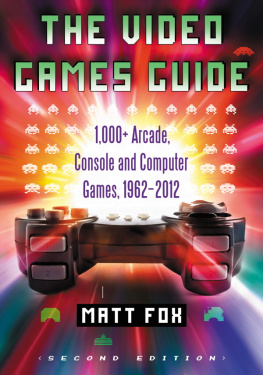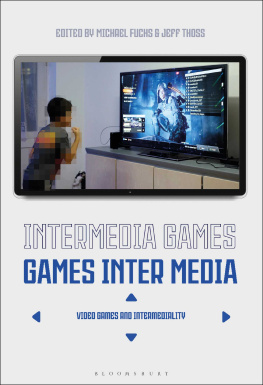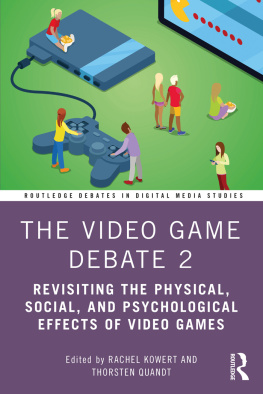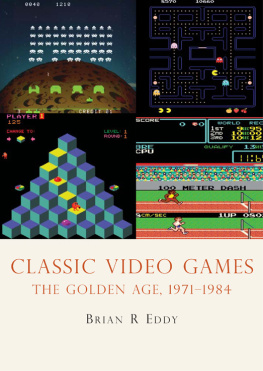Encyclopedia of Video Games
Encyclopedia of Video
Games
THE CULTURE, TECHNOLOGY, AND ART OF
GAMING
SECOND EDITION
VOLUME 1: AF
Mark J. P. Wolf, Editor

Copyright 2021 by ABC-CLIO, LLC
All rights reserved. No part of this publication may be reproduced, stored in a retrieval system, or transmitted, in any form or by any means, electronic, mechanical, photocopying, recording, or otherwise, except for the inclusion of brief quotations in a review, without prior permission in writing from the publisher.
Library of Congress Cataloging-in-Publication Data
Names: Wolf, Mark J. P., editor.
Title: Encyclopedia of video games : the culture, technology, and art of gaming / Mark J.P. Wolf, editor.
Description: Second edition. | Santa Barbara, California : ABC-CLIO, LLC, [2021] | Includes bibliographical references and index.
Identifiers: LCCN 2021007328 (print) | LCCN 2021007329 (ebook) | ISBN 9781440870194 (set) | ISBN 9781440878640 (v. 1 ; hardcover) | ISBN 9781440878657 (v. 2 ; hardcover) | ISBN 9781440878664 (v. 3 ; hardcover) | ISBN 9781440870200 (ebook)
Subjects: LCSH: Video gamesEncyclopedias.
Classification: LCC GV1469.3 .E65 2021 (print) | LCC GV1469.3 (ebook) | DDC 794.803dc23
LC record available at https://lccn.loc.gov/2021007328
LC ebook record available at https://lccn.loc.gov/2021007329
ISBN: 978-1-4408-7019-4 (set)
978-1-4408-7864-0 (vol. 1)
978-1-4408-7865-7 (vol. 2)
978-1-4408-7866-4 (vol. 3)
978-1-4408-7020-0 (ebook)
25 24 23 22 21 1 2 3 4 5
This book is also available as an eBook.
Greenwood
An Imprint of ABC-CLIO, LLC
ABC-CLIO, LLC
147 Castilian Drive
Santa Barbara, California 93117
www.abc-clio.com
This book is printed on acid-free paper 
Manufactured in the United States of America
Contents
Associations and Institutions
Business and Industry
Companies
Games
Other Media
People
Regions
Systems
Technology
Theoretical Concerns
Types of Games
In the decade since the First Edition of this encyclopedia was published, the terrain of games and game culture has changed immeasurably. Much of that change has come along with the explosion of independent game making independent, academic, amateur and otherwise and with the increased diversity of game makers that have come along with that explosion. Access to tools, opportunity for experimentation, and increased visibility for game makers outside of the commercial mainstream has been a predominant theme of these past ten to fifteen years.
My own experience with this surge of independence began in 2002 when I left the commercial game industry to join the fledgling USC Games program and started to gather a community of young, idealistic game designers together at the Game Innovation Lab under the shared goal of expanding the cultural presence of games. We, and others like us, looked to inspirations such as the New Games Movement and the punk rock and indie art music scenes; and we dreamed of making games that touched the human soul and spoke truth to power. A number of the games we made, and the people who made them are part of this revised encyclopedia, and so it seems fitting in that regard that I have been asked to provide an introduction to this new edition.
In looking over the new entries for this edition, I am pleased to see some important trends reflected here. I see a whole group of women designers newly included: Dona Bailey, Brenda Romero, Kellee Santiago, Theresa Duncan, Roberta Williams, Carol Shaw, and more, including myself, are all afforded entries in this new edition. I see discussions of new genres of games: free-to-play, newsgames, metagames, Zen mode, etc. The recognition of contemplative games such as Abz, The Night Journey and Walden, a game, strikes a particular chord for me, given my long-time work in the area. But I am equally excited to see entries for other emerging areas in games, such as eSports, Lets Play videos, and mixed reality; and for the capture of entries on historically important topics like Brown v. Entertainment Merchants Association, the collections at the Strong National Museum of Play, and even Gamergatestain on the culture of games that it is. As an educator and a designer, I am thrilled to see discussions of video game literacy, ontology, and rhetoric included here. In the growth of the field and its expressive possibilities, engagement with such topics becomes critical to our deepening understanding of our field. And, as a classic gamer, I am satisfied to see topics on our history as well as our future, added here, such as discussions of arcade cabinet art, Konami, and Zaxxon.
The list of entries in this new edition is not comprehensive, of course, and never can be not if we are to keep advancing the field and the people and ideas it encompasses. The universe of games is large, it contains multitudes, and so this new edition grows with that universe; but it cannot, and never should, fully comprehend it. It is up to us to continue to push past into the future of games, and to projects like this to recognize and historicize the work that we do as an industry and a community. It is my great honor to be a part of such a process.
Tracy Fullerton
Los Angeles, California
September 23, 2019
I guess a book about video games needs a foreword about the context of the business at the beginning, and I guess that I am the guy who should write it.
I got my start on a late night at the Merrill Engineering Building at the University of Utah, where I was studying engineering. There were big computers connected to video screens, and whenever that happens someone uses them to play games. The game I saw was Spacewar! written by Steve Russell from MIT. I was hooked. For the whole next two years, we programmed more than 20 games for play on the system, spending hours from midnight to 5 a.m. every weekend. We did everything from a little car racing game to fox and geese, from a very bad football game to tennis and hockey.
The piece of the puzzle that made me unique among the thousands of students who played the game was that I was working summers at an amusement park. It was called Lagoon, and it was a half-hour drive north from Salt Lake City. I had become the games manager that year and knew the economics of the amusement business and made the connection immediately. If this game could be put in one of the arcades at the park, it would make money. Further analysis said that the computers were too costly to be paid for 25 cents at a time.
Fast forward a few years. I had graduated, moved to California, and was working at Ampex as an Associate Electrical Engineer. I was playing Go with a programmer working at the Stanford Artificial Intelligence lab at Stanford, and he asked me if I wanted to come up and play Spacewar! I was hooked again. But this time I was in a position where I could act on my interest. I saw an ad for a Data General Nova Computer for $5,000. The cost looked like it could work.
My office mate was Ted Dabney, and I asked him if he wanted to join my company and give this a try. He said yes, and we were off to the races.
The problem was that computer displays were vector graphic units modified from radar displays and cost about $30,000 at that time. What was needed was a cheap monitor. A TV could be purchased for about $100 at the time, and I decided that a digital interface was the right approach.

![Mark J. P. Wolf (editor) Encyclopedia of Video Games: The Culture, Technology, and Art of Gaming [3 volumes]](/uploads/posts/book/279290/thumbs/mark-j-p-wolf-editor-encyclopedia-of-video.jpg)










